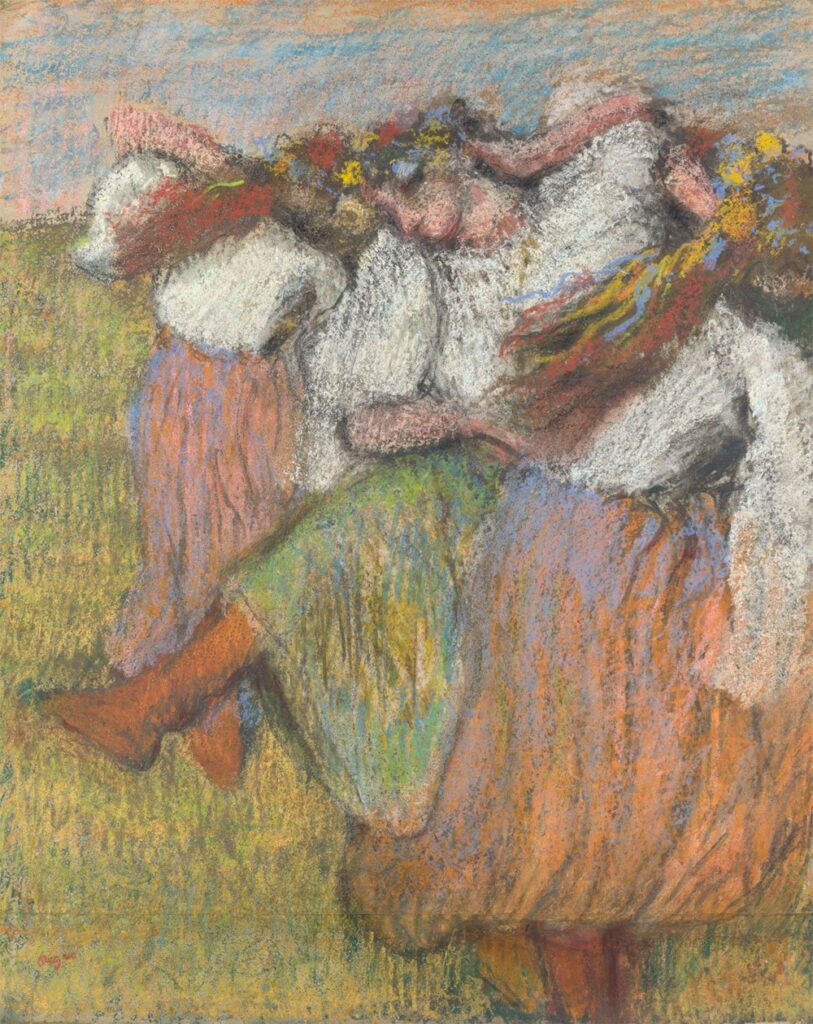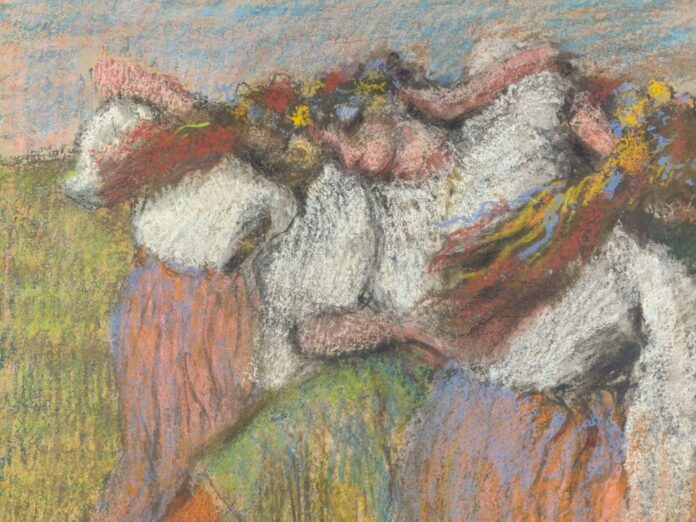After an outcry from Ukrainians on social media, London’s National Gallery has changed the name of Edgar Degas’ Russian Dancersto Ukrainian Dancers, reports the Guardian’s Ben Quinn. Created around 1899, the pastel drawing depicts figures bent over in motion, legs in mid-stride as they perform a traditional Ukrainian dance. The dancers’ hair is adorned with blue and yellow ribbons—the national colors of Ukraine.
“The title of this painting has been an ongoing point of discussion for many years and is covered in scholarly literature,” a museum spokesperson tells the Guardian. Given Russia’s ongoing invasion of Ukraine, the gallery “felt it was an appropriate moment to update the painting’s title to better reflect the subject of the painting.”
Not currently on display, Ukrainian Dancers portrays a troupe of dancers that Degas, who is best known for his depictions of erect, disciplined ballerinas, saw performing in Paris late in his life. The artist likely encountered these dancers at venues like the Moulin Rouge and the Folies-Bergère, notes Artnet’s Caroline Goldstein. The peasant dancers’ traditional folk costumes and long, ribbon-strewn hair inspired Degas to depict them in what he described as “orgies of color.”

Ukrainian heritage and culture are often mislabeled—casualties of the nation’s long history of occupation and association with its Eastern European neighbors. At the time of Degas’ drawings, Ukraine was part of the Russian Empire. Beginning in the 1880s, Alexander III implemented a “Russification” policy that sought to wipe out nationalist movements and encourage a shared Russian national identity across the empire.
“In the [mainstream] media, few can discern whether an artwork was created in the Ukrainian, Georgian, Estonian or the Russian Soviet Socialist Republic,” wrote Ukrainian film critic Daria Badior for Hyperallergic last month. “[I]t just seems, to the general public, like Soviet art and therefore Russian.”
Long subjected to Russian conquest and control, Ukraine most recently regained its independence with the collapse of the Soviet Union in 1991. Though Ukrainians have, in recent years, reasserted their cultural identity by speaking Ukrainian and embracing local traditions, Russian President Vladimir Putin has continually denounced these efforts, describing Ukrainian as the “language of peasants” and perpetuating the Soviet-era stereotype that modern Ukraine was completely created by Russia.
Mariam Naiem, an Afghanistan-born Ukrainian activist and artist, tells Hyperallergic’s Valentina Di Liscia that the Degas pastel’s new name is a “micro victory.”
“Russian imperialism destroyed everything related to Ukrainian culture for centuries: The Ukrainian language was subject to linguicide, writers were exiled, poets were shot and some artists were killed in unthinkable ways,” she says. “… More than ever, we must understand what each forgotten Ukrainian artifact, appropriated artist or cultural object is worth to us.”
The move to a more culturally sensitive title has inspired calls for other institutions to similarly reexamine their holdings. Writing for Der Spiegel, Olesya Khromeychuk, a historian and the director of the Ukrainian Institute London, argues that museums’ homogenization of Ukrainian and Russian cultures gives Putin a leg up in his seeming attempt to resurrect the U.S.S.R.
“Culture and history take a prominent place in [Putin’s] arsenal,” she explains, adding that she objects to the “deliberate or just lazy misinterpretation of the region as one endless Russia.”
Russia’s invasion of Ukraine has prompted other renamings, too, from a campaign to retitle streets near Russian embassies after Ukraine to the redubbing of a camera system formerly known as the “Russian arm” and now branded the “U-Crane.”
The Metropolitan Museum of Art and the Museum of Fine Arts, Houston, both house drawings from the Degas pastel series in their collections. Both institutions refer to the dancers as “Russian.” Neither responded to Artnet’s inquiries about a potential name change.
Another institution has addressed the misnaming head on: On the website for its 2016 exhibition “Degas: Russian Dancers and the Art of Pastel,” the Getty Center writes, “[C]urrent circumstances call for clarification. The so-called Russian dancers in this pastel are Ukrainian dancers.”























